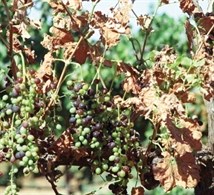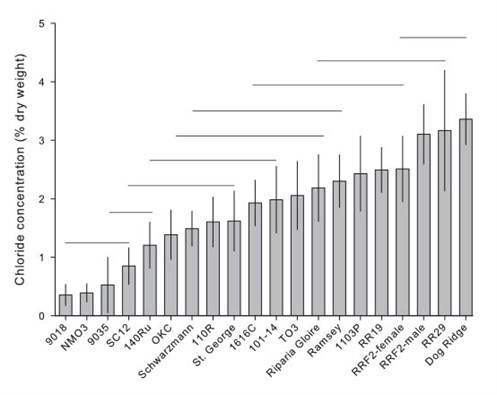Insights on mitigating sodium chloride issues from Dr. Andy Walker of the Department of Viticulture and Enology, University of California Davis and Novavine viticulturist Jeff Wheeler

Saline conditions in both soil and irrigation water have always been an issue in agriculture. This is even more the case in semi-arid, drought-prone areas like California. Whether it’s sea water intrusion into existing wells, the higher concentrations of sodium and chloride in ground water as it recedes further downward, or the fact that new wells have to be drilled into less desirable aquifers, irrigation water is becoming more saline in many areas.
Minor sodium chloride toxicity can express itself in grapevines as suppressed growth, generally due to lower photosynthesis and compromised mineral nutrient uptake. It can also be expressed by lower fruitfulness, smaller cluster size, reduced brix, and delayed ripening—among other maladies. Higher concentrations of sodium chloride are expressed as even more extreme symptoms that can eventually lead to vine death.
Leaching and soil amendment
Mitigating salinity issues is possible, but can be complex. Chloride can easily be leached from the soil profile. With ample amounts of non-saline water, chlorides will move through and out of the root zone. Soils that are sandy in texture need less clean leachable water than those soils that contain more clay.
Due to its positive charge, sodium does not leach as easily through the soil matrix. Sodium’s relatively small size and positive charge causes soil particles to be tighter and less porous. This along with its tendency to bind to negatively charged soil particles makes it difficult to leach. Additions of gypsum (calcium sulfate) late in the season—so as to allow winter rains to move it into the soil profile—are important. This process causes the sodium to be bound to the sulfate in gypsum as sodium sulfate. This sodium sulfate moves out of the soil profile much easier than sodium itself. This sodium sulfate molecule frees up more calcium that will help with soil porosity, allowing greater water infiltration and leaching.
Rootstocks
Rootstock choice is a great strategy to mitigating saline conditions. According to Dr. Andy Walker, Department of Viticulture and Enology University of California Davis, chloride exclusion is the most important aspect for saline tolerance in grapevine rootstocks. Of the current rootstock choices, 140 Ruggeri and Schwarzmann are the two best choices for chloride exclusion and thus salt tolerance. The graph below depicts different rootstocks and their relative chloride exclusion. Those with lower chloride percentages represent better salt tolerance. One will notice names or numbers that do not correspond with current available rootstocks, such as OKC. These represent potential future rootstocks and salt-resistant selections that Dr. Walker and his team are currently researching. Many have great promise when it comes to saline tolerance and future commercial availability is on the horizon.
Shadehouse screen, 75 mM NaCl
Saline conditions are an ever-present issue when it comes to farming. While this condition has the potential to make farming more difficult it is now possible to mitigate many of these issues. A complex solution involving all management practice, amendments, rootstocks etc. is recommended.


